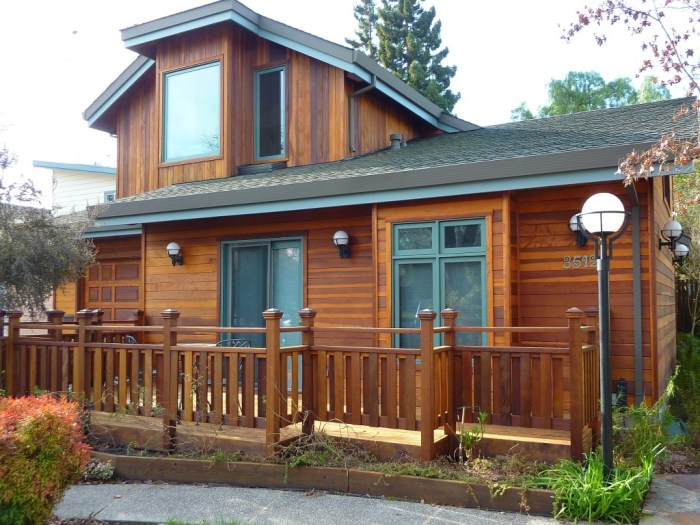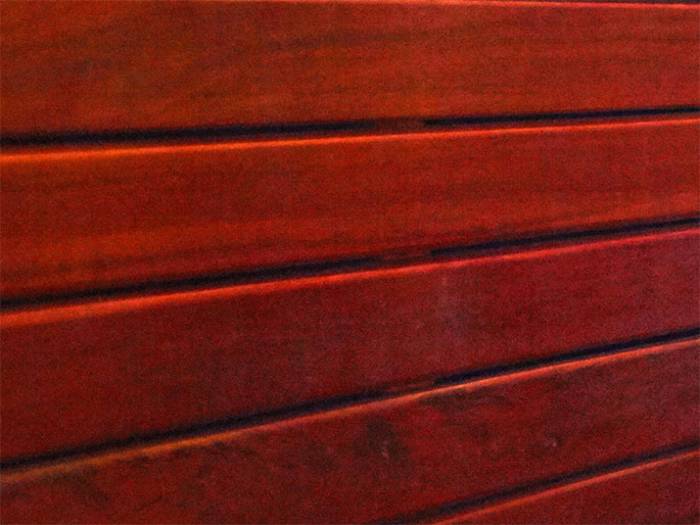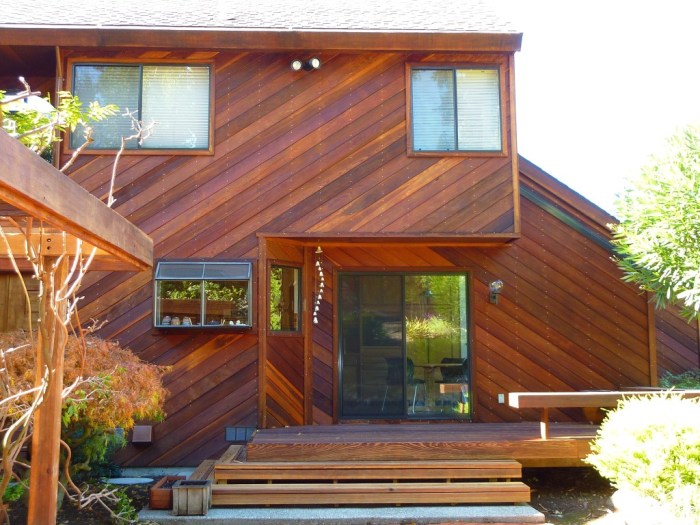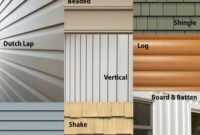Redwood siding, with its rich hues and natural texture, offers a timeless appeal that elevates any home’s aesthetic. From its inherent durability to its sustainable sourcing, redwood presents a compelling alternative to other siding materials. This guide delves into the multifaceted world of redwood siding, exploring its aesthetic versatility, practical maintenance, environmental impact, installation process, and diverse applications, empowering you to make an informed decision for your next project.
We’ll examine the various styles, from classic board and batten to contemporary shiplap, and compare redwood’s cost-effectiveness and longevity against vinyl, fiber cement, and other options. Discover how responsible forestry practices contribute to redwood’s sustainability, and learn how to properly maintain your redwood siding to ensure its lasting beauty and resilience.
Redwood Siding Aesthetics and Design

Redwood siding offers a unique blend of natural beauty and durability, making it a popular choice for homeowners seeking a visually appealing and long-lasting exterior. Its aesthetic appeal stems from the inherent characteristics of the wood itself, resulting in a wide range of visual possibilities depending on the application and finishing techniques.
Redwood Siding Visual Appeal: Grain Patterns and Color Variations
Redwood’s visual appeal is largely defined by its distinct grain patterns and color variations. The grain, ranging from straight and tight to more pronounced and irregular, contributes to the overall texture and character of the siding. Coloration varies from a light, reddish-brown to a deep, rich brown, often darkening with age and exposure to the elements. This natural weathering process adds to the rustic charm of redwood, creating a unique patina that many homeowners find attractive. The inherent variations in color and grain contribute to a natural, organic look, unlike the uniformity of many manufactured siding materials. Different cuts of redwood, such as vertical grain or flat grain, will also impact the appearance, influencing the prominence of grain lines and the overall texture.
Comparison of Redwood Siding with Other Materials
Compared to vinyl siding, redwood offers a more substantial and natural appearance. Vinyl, while low-maintenance and affordable, often lacks the depth and character of real wood. Fiber cement siding, another popular alternative, provides excellent durability and fire resistance, but its smooth, often painted surface lacks the organic texture and inherent color variations of redwood. While both vinyl and fiber cement offer a range of colors and styles, they cannot replicate the unique visual appeal of naturally aged redwood. The inherent warmth and character of redwood make it a preferred choice for homeowners who value a natural, high-end aesthetic.
Design Considerations for Redwood Siding Across Architectural Styles
Redwood siding’s versatility allows its integration into various architectural styles. In farmhouse designs, its natural tones and textures complement the rustic aesthetic, often paired with exposed beams and stone accents. For modern homes, redwood can be used in sleek, clean lines, possibly with a more contemporary stain or finish to emphasize its inherent beauty without overwhelming the minimalist design. Victorian homes, with their intricate detailing, can benefit from redwood’s ability to showcase both subtle and dramatic textural elements. The choice of siding profile, such as bevel, clapboard, or shiplap, can further enhance the aesthetic integration within the specific architectural style.
Cost-Effectiveness of Redwood Siding Compared to Alternatives
| Material | Average Cost per Square Foot | Lifespan (Years) | Maintenance Requirements |
|---|---|---|---|
| Redwood | $8-$15 | 50+ | Regular cleaning, occasional staining/sealing |
| Vinyl | $3-$8 | 20-30 | Minimal cleaning |
| Fiber Cement | $6-$12 | 50+ | Periodic cleaning, occasional painting |
| Engineered Wood | $5-$10 | 30-40 | Regular cleaning, occasional staining/sealing |
Redwood Siding Durability and Maintenance

Redwood siding, renowned for its beauty, also boasts exceptional durability and longevity. Its inherent properties contribute to its resistance against the elements and common threats to exterior cladding, resulting in a significant return on investment for homeowners. Understanding the maintenance requirements ensures the siding’s aesthetic appeal and structural integrity remain intact for decades.
Redwood’s Natural Resistance to Decay and Insect Infestation
Redwood possesses natural resistance to decay and insect infestation due to its high concentration of extractives, particularly tannins and other organic compounds. These compounds act as natural preservatives, inhibiting the growth of fungi and deterring insects like termites. This inherent resistance significantly reduces the need for chemical treatments compared to other wood species, contributing to its environmental friendliness and long lifespan. However, it’s important to note that even redwood’s natural defenses can be compromised under certain conditions, such as prolonged exposure to excessive moisture or in environments with high insect populations.
Redwood Siding Maintenance Procedures
Proper maintenance is crucial for maximizing the lifespan and aesthetic appeal of redwood siding. A regular maintenance schedule will help prevent premature deterioration and ensure the siding remains a beautiful and functional part of your home’s exterior. This includes cleaning, staining, and sealing, each playing a vital role in protecting the wood.
- Cleaning: Regular cleaning removes dirt, mildew, and other debris that can accumulate on the siding’s surface. A gentle solution of mild detergent and water, applied with a soft brush or pressure washer (using low pressure to avoid damaging the wood), is usually sufficient. Annual cleaning is recommended, with more frequent cleaning in areas with heavy pollution or coastal environments.
- Staining: Staining enhances the natural beauty of redwood while providing additional protection against UV damage and weathering. Choosing a high-quality, exterior-grade stain specifically designed for redwood is crucial. Proper application, following the manufacturer’s instructions, ensures even coverage and maximum protection. Re-staining every 3-5 years, depending on the climate and stain type, is typically recommended.
- Sealing: Applying a high-quality wood sealant creates a protective barrier against moisture penetration. This is especially important in areas with high humidity or rainfall. Sealants help prevent rot, warping, and insect infestation. Similar to staining, re-application every 3-5 years is generally recommended, though the frequency might increase in harsher weather conditions.
Lifespan of Redwood Siding Under Different Environmental Conditions
The lifespan of redwood siding varies depending on several factors, primarily the environmental conditions. In ideal conditions, redwood siding can last for 50 years or more. However, coastal environments, characterized by high humidity, salt spray, and strong winds, can accelerate weathering and decay, potentially reducing the lifespan to 30-40 years. Inland climates, with less moisture and salt exposure, generally offer longer lifespans, closer to the upper end of the range. Proper maintenance, as described above, significantly extends the lifespan in all environments. For example, a well-maintained redwood home in a dry, inland climate in California might easily surpass 50 years, whereas a similar home exposed to constant sea spray on the Oregon coast might require more frequent maintenance and have a shorter overall lifespan.
Applying a Protective Sealant to Redwood Siding: A Step-by-Step Guide
Proper sealant application is critical for optimal protection. Before starting, ensure the siding is clean, dry, and free from any loose debris or mildew. Using a high-quality exterior-grade sealant specifically designed for redwood is essential.
- Preparation: Clean the redwood siding thoroughly as described above. Allow it to dry completely before proceeding.
- Application: Using a brush or roller, apply the sealant evenly to the surface of the siding, following the manufacturer’s instructions. Work in small sections to avoid uneven application or drying before coverage is complete.
- Drying Time: Allow the sealant to dry completely before exposing the siding to rain or moisture. Refer to the manufacturer’s instructions for the recommended drying time.
- Re-application: Reapply the sealant as needed, typically every 3-5 years, depending on the environmental conditions and the sealant’s performance.
Environmental Impact of Redwood Siding
Redwood siding, while aesthetically pleasing and durable, carries an environmental footprint that needs careful consideration. This section examines the sustainability of redwood as a building material, comparing its impact to alternatives and exploring its effects on local ecosystems. Understanding this impact is crucial for making informed decisions about sustainable building practices.
Sustainable Forestry Practices and Redwood
Responsible forestry practices are paramount to minimizing the environmental impact of redwood harvesting. Sustainable forestry involves managing redwood forests for long-term health and productivity, ensuring that harvesting rates do not exceed regeneration rates. This includes selective logging, which targets mature trees while preserving younger trees and the overall forest ecosystem. Certification programs, such as the Forest Stewardship Council (FSC), provide a framework for verifying responsible forestry practices, offering consumers assurance that the redwood used in their siding comes from sustainably managed forests. Companies adhering to these standards actively replant trees, protect biodiversity, and minimize soil erosion, contributing to a more sustainable supply chain.
Environmental Footprint Comparison: Redwood vs. Other Siding Materials
Comparing the environmental footprint of redwood siding with other options requires examining several factors, including carbon emissions during manufacturing and transportation, resource consumption (water and energy), and the embodied carbon – the total greenhouse gas emissions associated with a product’s entire lifecycle. While redwood is a carbon-sequestering material, meaning it absorbs and stores carbon dioxide from the atmosphere during its growth, the manufacturing process and transportation still contribute to its overall carbon footprint. Other materials, such as vinyl and composite siding, often have lower embodied carbon during manufacturing but lack the carbon sequestration benefits of redwood. Furthermore, the production of these materials can be energy-intensive and rely on non-renewable resources. The lifecycle assessment of each material is crucial for a comprehensive comparison. For example, a study by [insert credible source and study details here] may provide quantifiable data on the comparative carbon footprints of various siding materials.
Impact on Local Ecosystems and Biodiversity
Harvesting redwood, even under sustainable practices, can have some impact on local ecosystems and biodiversity. Habitat disruption and fragmentation are potential concerns, although responsible forestry aims to minimize these effects through selective logging and careful planning. The long lifespan of redwood trees means that their removal can alter the structure and function of the forest for a considerable time. However, well-managed forests can maintain biodiversity by providing habitat for various plant and animal species. The potential for negative impacts can be mitigated by adhering to strict guidelines and regulations, such as those set by governmental agencies and environmental organizations.
Environmental Credentials of Different Siding Materials, Redwood siding
| Siding Material | Renewable Resource? | Recyclability | Embodied Carbon (kg CO2e/m²) |
|---|---|---|---|
| Redwood | Yes | Limited (depending on condition) | [Insert data from credible source, e.g., 500-700] |
| Vinyl | No | Low | [Insert data from credible source, e.g., 300-500] |
| Fiber Cement | Partially (cement component) | Limited | [Insert data from credible source, e.g., 800-1000] |
| Cedar | Yes | Limited (depending on condition) | [Insert data from credible source, e.g., 600-800] |
Installation and Cost of Redwood Siding
Redwood siding installation, while achievable by skilled DIYers, often benefits from professional expertise to ensure longevity and aesthetic appeal. Proper preparation, precise fastening, and meticulous finishing are crucial for a successful project. This section details the process, required materials, cost factors, and a visual representation of a typical installation.
Redwood Siding Installation Process
The installation process involves several key steps. First, the existing siding (if any) must be removed, and the underlying wall inspected for damage. Any necessary repairs, such as replacing rotted wood or addressing structural issues, should be completed before proceeding. Next, water-resistant barrier is installed, followed by the installation of furring strips to create an air gap for ventilation and moisture control. The redwood siding is then applied, starting at the bottom and working upwards, ensuring proper overlap and alignment. Each piece is carefully fastened using appropriate nails or screws, avoiding over-driving which could split the wood. Finally, caulk is applied to seal gaps and joints, and any necessary trim or finishing pieces are added.
Tools and Materials Required for Redwood Siding Installation
Proper tools and materials are essential for a successful installation. Using substandard materials can compromise the longevity and aesthetics of the project.
- Measuring tape and level
- Circular saw or hand saw
- Hammer or nail gun
- Drill with appropriate drill bits
- Caulk gun
- Safety glasses and gloves
- Redwood siding boards (appropriate length and quantity)
- Nails or screws (galvanized or stainless steel)
- Water-resistant barrier (housewrap)
- Furring strips (treated lumber)
- Caulk (exterior-grade)
- Trim pieces (as needed)
Factors Influencing the Cost of Redwood Siding Installation
The total cost of redwood siding installation is influenced by several factors. Material costs vary depending on the grade and thickness of the redwood, and the quantity required. Labor costs are significant, particularly for larger projects or those requiring specialized expertise. Regional differences in labor rates and material availability also contribute to price fluctuations. For example, a project in a rural area may have higher labor costs due to limited availability of contractors, while an urban area might have higher material costs due to increased demand and transportation expenses. Permitting fees and other incidental costs should also be factored into the overall budget.
Visual Description of a Typical Redwood Siding Installation
Imagine a wall clad in redwood siding. The image shows a neat, vertical arrangement of redwood boards, each overlapping the one below by approximately an inch. The consistent spacing between boards allows for proper ventilation and prevents moisture buildup. At the bottom, a starter strip provides a level base for the first row of siding. At the top, a cap or trim piece neatly finishes the installation. The boards are securely fastened with galvanized nails, barely visible against the reddish-brown wood. The housewrap is visible in areas where the siding is not yet installed, and furring strips are subtly apparent beneath the siding, providing the necessary air gap. The overall impression is one of natural beauty and durability, showcasing the rich texture and color of the redwood. A slight shadowing effect between the boards emphasizes the depth and three-dimensionality of the siding. The careful caulking around windows and other penetrations is barely noticeable, demonstrating a clean and professional finish.
Redwood Siding Styles and Applications

Redwood siding offers a diverse range of styles and applications, allowing for considerable aesthetic and functional flexibility in residential and commercial projects. The choice of siding style significantly impacts the overall look and feel of a structure, while also influencing its durability and maintenance requirements in different climates. Understanding these nuances is crucial for selecting the most appropriate redwood siding for a given project.
The inherent beauty and versatility of redwood allow it to seamlessly integrate into a variety of architectural styles, from rustic cabins to modern minimalist homes. Its natural resistance to decay and insects further enhances its suitability for various exterior applications, extending the lifespan of structures and reducing long-term maintenance needs.
Redwood Siding Styles
Redwood siding is available in several distinct styles, each contributing unique visual characteristics and performance attributes. The choice depends on personal preference, architectural style, and budget.
- Board and Batten: This classic style features wide vertical boards with narrow strips of wood (battens) covering the seams. It creates a clean, linear look, often associated with traditional and rustic designs. The battens add depth and shadow, enhancing the texture of the siding. This style is well-suited for both vertical and horizontal applications.
- Shiplap: Characterized by overlapping horizontal boards, shiplap siding creates a seamless, weather-resistant surface. The overlapping design enhances its water-resistance. This style offers a clean, contemporary look, frequently used in modern and farmhouse-style homes. Its horizontal lines can visually widen a structure.
- Clapboard (Bevel Siding): Clapboard siding consists of tapered boards that overlap, creating a staggered appearance. This traditional style offers excellent weather protection and is suitable for various architectural styles, from colonial to contemporary. The subtle texture and shadow lines add visual interest.
Redwood Siding Applications
Redwood’s natural beauty and durability make it ideal for a wide array of applications beyond traditional house siding. Its versatility extends to creating striking visual accents and functional elements throughout a property.
- Exterior Walls: The most common application, redwood siding provides a beautiful and durable exterior for homes and commercial buildings. The choice of style and finish can drastically alter the overall aesthetic.
- Fences and Gates: Redwood’s natural resistance to rot and insects makes it an excellent choice for fences and gates. Different siding styles can create a variety of looks, from rustic to modern. The longevity of redwood reduces the need for frequent repairs or replacements.
- Accent Features: Redwood siding can be used creatively to accentuate architectural details, such as dormers, bay windows, or entryways. Using a contrasting style or finish can draw attention to these features and add visual interest to the building’s facade.
Redwood Siding Suitability Across Climate Zones
The suitability of different redwood siding styles varies depending on the climate. For example, in areas with heavy rainfall, shiplap or clapboard, with their overlapping design, might be preferred for enhanced water resistance. In drier climates, board and batten, while equally durable, might be a suitable choice for its aesthetic appeal. Proper sealing and maintenance are essential regardless of the climate to ensure the longevity of the redwood siding.
Innovative and Creative Uses of Redwood Siding in Contemporary Architecture
Redwood’s inherent versatility lends itself to innovative applications in modern architecture.
- Screen Walls and Privacy Screens: Thin redwood strips can be used to create stylish and functional screen walls, providing privacy while allowing for natural light and ventilation. These screens can be incorporated into balconies, patios, or gardens, adding a natural element to the outdoor space. An example would be a modern home incorporating a vertical redwood screen wall to separate the patio from the street, offering privacy while maintaining an open feel.
- Interior Cladding: Redwood’s natural warmth and beauty extend beyond exterior applications. It can be used as interior cladding in hallways, accent walls, or even ceilings, creating a cohesive design that flows from the exterior to the interior. A spa or wellness center might use redwood interior cladding to create a calming and natural atmosphere.
- Soffits and Fascia: Redwood’s durability makes it an ideal material for soffits and fascia, protecting the underlying structure from the elements. Its natural look complements various architectural styles, adding a touch of elegance and sophistication.
Ultimately, the choice of redwood siding represents a commitment to both aesthetic excellence and environmental responsibility. Its natural beauty, remarkable durability, and sustainable origins make it a premium choice for homeowners seeking a lasting and visually stunning exterior. By understanding the nuances of its installation, maintenance, and environmental impact, you can confidently incorporate redwood siding into your building project, creating a home that reflects your unique style and values for years to come. This comprehensive guide equips you with the knowledge needed to make an informed decision, ensuring your redwood siding investment delivers lasting beauty and value.
Key Questions Answered
What are the common problems with redwood siding?
While durable, redwood can be susceptible to warping or cracking if not properly sealed and maintained, especially in harsh climates. Insect infestation is also a potential concern, though less so with heartwood redwood.
How often should I stain or seal my redwood siding?
The frequency depends on your climate and the type of finish used. In most cases, re-staining or sealing every 3-5 years is recommended to maintain protection and aesthetics.
Can I install redwood siding myself?
While possible for experienced DIYers, professional installation is often recommended for optimal results and to ensure a long lifespan. The complexity depends on the siding style and the project’s scope.
Is redwood siding fire-resistant?
Redwood is naturally more resistant to fire than some other wood species, but it is not fireproof. Proper fire safety measures should still be implemented.
How does redwood siding compare to cedar siding?
Both are naturally durable, but redwood generally boasts superior resistance to decay and insect damage. Cedar often has a more pronounced aroma. Cost can vary depending on region and availability.


